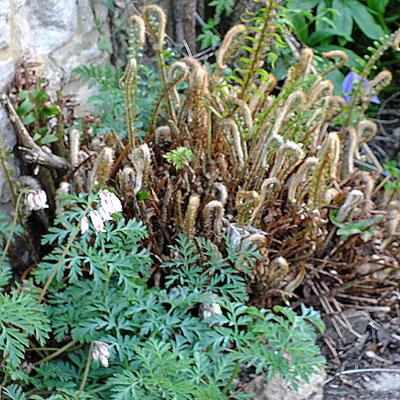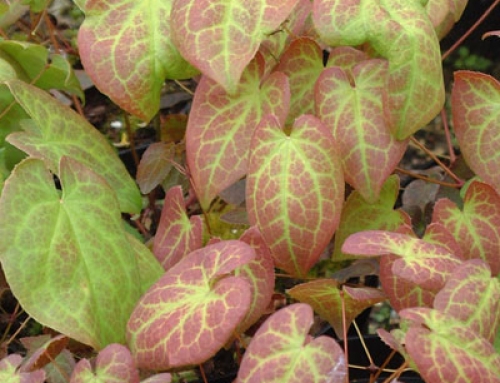Follow the links to the right to find out more about ferns. Alternatively just scroll down the page to see lots of pictures to inspire you.
Ferns
The cultivation of ferns is a huge subject, way beyond the scope of the few words I will write here. However I’ll do my best to give some notes on each genus and its peculiarities of cultivation and any other information that strikes me as interesting.
The craze for growing ferns originates in the Victorian age, gaining momentum in the latter half of the 19th Century. Fuelled by and explosion of literature Victorians went forth into the countryside to study and collect native specimens by the armful. Just as there was huge interest, so a multitude of varieties and variations were spotted, collected and names. Many, many are now lost, but some still remain and can frequently be identified by the now outlawed Latinised cultivar names such as Polystichum setiferum ‘Plumosum Densum’.
Whilst most ferns enjoy moisture and a soil that never dries out completely, the requirement for water is not as necessary as many might believe. In fact, the list of ferns that enjoy a boggy site is probably much smaller than a list of those that will tolerate a dry site. Athyrium, Osmunda and Matteuccia are amongst the wettest lovers. Try these pages for more information on moisture requirements.
A generalisation would be that ferns like a fertile soil with good drainage. Many grow very well on shady banks. They frequently do best in bright shade, with most ferns being able to take a reasonable amount of sun providing that they do not endure full sun during the middle of the day. Asplenium is perhaps the most notable exception, with its leaves sometimes scorching.
As regards PH, most ferns will grow quite happily in any soil that doesn’t have and extreme of either acidity or alkalinity. If you were to rank them, Dryopteris, Athyrium and Osmunda would prefer a soil on the acid side, with Polystichum and Asplenium preferring it alkaline. This however should be taken a s a guide not a strict prescription.
So to sum up, provided you can avoid a sunny South facing bank, or dry site on sand, you are likely to have success with ferns in a wide range of positions and soils. You might like to look at the following page to help refine your choices.
Adiantum
Lovely ferns whose delicate appearance belies their extreme hardiness, coming as they do from very Northerly regions. They are tolerant of most soil types, tending possibly towards a preference for the alkaline. The main thing to avoid is windy site. They are quite short, mostly around 30cm, maybe a little taller and form dense deciduous clumps of wiry stems.
Asplenium
A very large Genus covering wildly different ferns from diverse habitats. In British gardens it is most represented by just a few species, predominantly the British native Asplenium scolopendrium – the Hart’s Tongue Fern. This ferns grows, but does not thrive in acid conditions, preferring some lime in the soil. It is an excellent choice for contrast in a collection of ferns and tolerates dry sites well once established. There are a wealth of varieties showing different leaf forms, from the narrow to the broad, heavily crested forms and ones with the most elaborately goffered edges. Prefers a position in shade.
Asplenium scolopendrium has been placed in Phyllitis, from which it has since moved back.
Asplenoum derives from the Greek ‘a’ = not and ‘splen’ = spleen, a reference to fancied medicinal properties
scolpendrium comes from a fancied resemblance of the sori to the feet of a centipede (scolopendra)
Asplenium scolopendrium – Hart’s Tongue, Hind’s Tongue, Buttonhole, Horse Tongue, God’s Hair, Lingua cervina
Athyrium
The female ferns. A large genus of deciduous ferns of generally fine appearance. Much more lady-like than the more brutish male ferns.
They tend to lose their fronds fairly quickly with the first air frosts of Autumn
The female fern has a very wide distribution from Britain down into Africa and across the Northern Hemishere. It is a real damp lover, preferring an acid soil, but still growing well in alkaline conditions. It will take full sun if it has ample moisture at the root. Many cultivars , upwards of 300, have been identified and named.
Dryopteris
Male Ferns. This is a genus of robust ferns which vary from the evergreen through to the deciduous. Many are highly suitable for dry sites, with Dryopteris dilitata being a notable exception. Species like Dryopteris affinis have beautifully coloured fronds in spring, opening yellow with golden scales on the rachis. Dryopteris erythrosora and Dryopteris lepidopoda both from the Far East have fronds that emerge in gorgeous russet tones, only gradually fading through yellow to green. They are some of the least demanding and most worthy large ferns.
The ashes of the Male fern, in common with Bracken, have been used in the production of soaps as well as finding use in glassmaking. In times of hardship, the young fronds have been eaten like asparagus and the Norwegians in desperation have added them to bread and beer in past times.
Dryopyeris derives from the Greek ‘drys’ = oak and ‘pteris’ = fern.
Matteuccia
These are plants of wet places, thriving at the edge of water. They are unsurpassed for the even grace of their shuttlecock form. Ample moisture is a prerequisite, with a little shade being advisable to prevent leaf scorch in the Summer.
Matteuccia commemorates a 19th Century Italian Physicist Carlo Matteucci
struthiopteris derives from the Greek ‘struthokamelos’ = Ostrich and ‘pteris’ = fern
Polypodium
Polypodys are ferns of dry sites with good drainage. In the wild they are frequently to be found growing in and around the hedge base on banks and in more humid areas growing as epiphytes on the branches of trees. They like good air circulation. They can make excellent ground cover, the rhizomes making a near impenetrable mat above which is a lovely fresh green carpet of fronds. They tend towards evergreen but in really cold seasons the fronds can dry in place and linger.
Polypodium derives from the Greek ‘ploys’ = many and ‘podos’ = foot, a reference to the branching of the rhizome
Polystichum
A large genus of mostly evergreen ferns, many suited to dry sites. Many form substantial clumps of highly decorative fronds up to 90cm across. Whilst most are evergreen it usually pays to remove all of the old fronds just as you see the new ones unfurling as the scaly nature and beautiful geometry of the new fronds is one of the joys of the Spring garden.
A little lime in the soil can be beneficial to the growth of polystichums. Avoid waterlogging.
Polystichum derives from the Greek ‘Polys’ = many and ‘stichos’ = row’, referring to the many rows of spore carrying sori.





































































Leave A Comment
You must be logged in to post a comment.